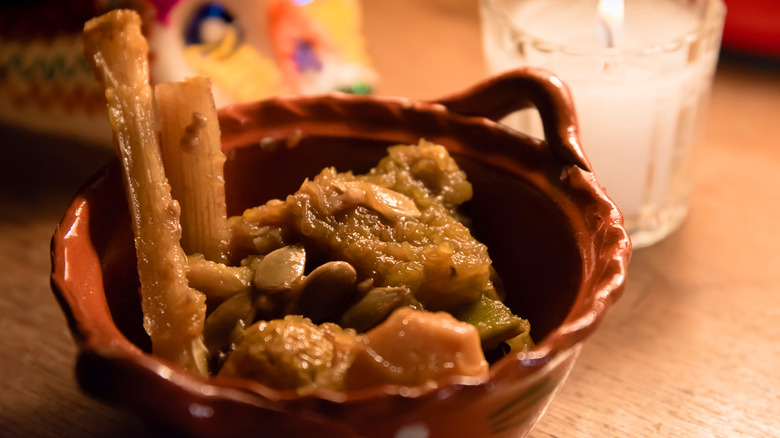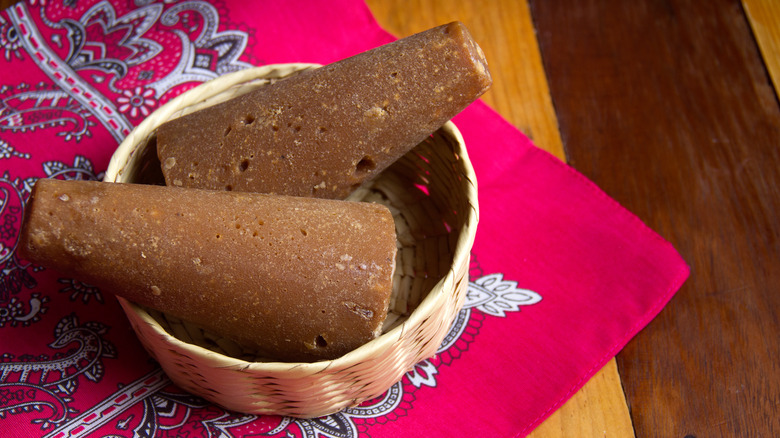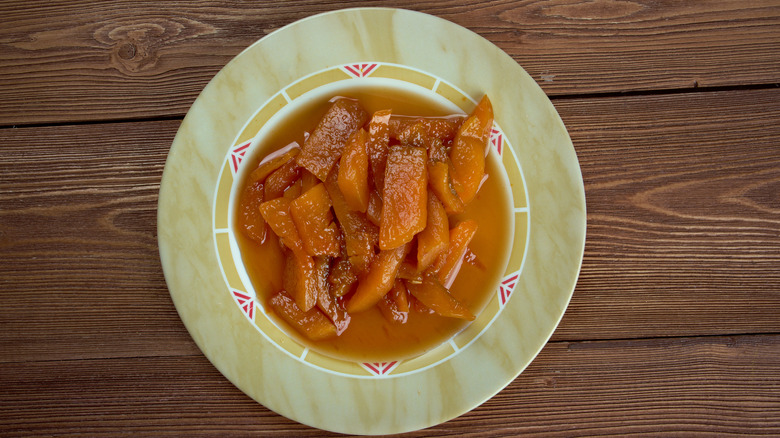Calabaza En Tacha: The Mexican Pumpkin Treat You Should Know
As piles of pumpkin pop up in your local grocery stores and sweet pumpkin-infused desserts appear advertised, well, everywhere, you may be thinking of ways to use the squash at home.
Pumpkins' seeds can be scraped out, cleaned, and dried to make a perfectly crispy and salty snack, either eaten alone, tossed in salads, or baked into homemade granola. Of course, the pumpkins' flesh can be eaten, popularly roasted or made into pumpkin purée. Roasted pumpkin can be made into savory salads while the purée can be mixed into almost anything. From ravioli to soups to desserts, like the classic and creamy pumpkin pie, the purée is an ideal ingredient in a variety of meals. Even the stems, leaves, and flowers are edible, according to Tyrant Farms.
However, there is one pumpkin-y fall dessert that may reign supreme: Calabaza en Tacha is a Mexican dessert with pumpkin pieces covered in a thick, sugary syrup that just might be the perfect autumnal treat.
History of Calabaza en Tacha
According to Mommy Maestra, pumpkins are a native fruit to Mexico that have been cultivated there for thousands of years. Indigenous farmers, including Aztecs and Mesoamericans, grew pumpkins in Central Mexico for a variety of uses, such as grinding the seeds into sauces and using the shells as cups. These pumpkins, however, did not look like the orange pumpkin we typically see in the U.S. According to Kitchn, Calabaza de Castilla is a green and brown winter squash that looks like a butternut squash inside.
When the Spanish conquered Mexico, they discovered the pumpkin and brought their findings back to the queen, Isabella I of Castile, and she loved the pumpkin so much she named it after herself. This is the pumpkin that is still used in traditional Calabaza en Tacha. Typically, this dish is eaten during Día de los Muertos (Day of the Dead) celebrations (via Kitchn).
The Day of the Dead originated with the Aztecs. According to Mommy Maestra, Mictecacihuatl was the Aztecs' queen of the underworld and afterlife in their mythology.
How Calabaza en Tacha is made
Mexico in my Kitchen says that every region across Mexico prepares this dish a little differently. However, the typical ingredients list includes pumpkin, Piloncillo syrup, and cinnamon sticks. Piloncillo, according to The Spruce Eats, is a raw form of sugar cane that tastes similar to molasses and is typically sold as "cones" in Mexican grocery stores. It is simple to make the syrup: Just simmer Piloncillo and water together to make this sweet condiment (via Muy Delish).
To prepare Calabaza en Tacha, the pumpkin needs to be cut into small, bite-sized pieces — about 3 inches, according to Mexico in my Kitchen's recipe. The pieces are then placed in a large pot, along with Piloncillo cones, cinnamon sticks, and optional spices for flavor like anise, cloves, or orange slices.
Once the Piloncillo is dissolved, the dish is covered and simmered for about half an hour. After this, the pumpkin should be done cooking. It is then removed to allow the syrup to reduce. Once thickened, the pumpkin is served with a drizzle of the syrup (Mexico in my Kitchen).
How to enjoy Calabaza en Tacha
There is no wrong way to serve Calabaza en Tacha. Sometimes it is served doused in thick syrup, while others prefer to eat it dryer, according to Mexico in my Kitchen. Condensed milk or cajeta can also be drizzled over, with pecans and pine nuts on top (via Maricruz Avalos). The time of day this dish is consumed can also vary. While this dish is a dessert, some people in Mexico eat it for breakfast, along with a cold glass of milk (via Mexico in my Kitchen).
Calabaza en Tacha is most commonly served around the Día de los Muertos (Day of the Dead) celebrations, which run from October 30 to November 2. This holiday is dedicated to honoring and celebrating loved ones that have passed on. Not only is this dish eaten in Mexican households, but it is often placed on traditional altars. These altars can be decorated with photographs and personal mementos, but food items are also commonly added (via Mexican Made Meatless).



